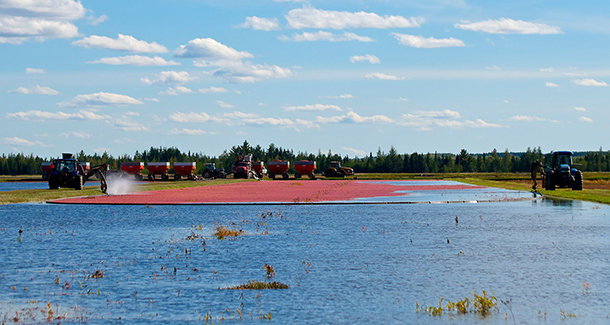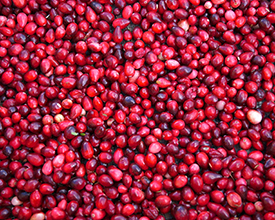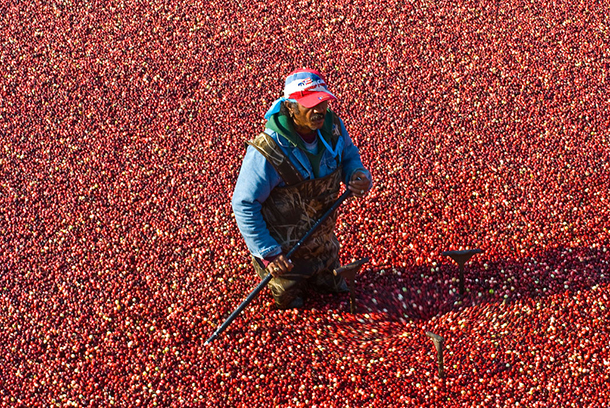Organic Cranberries: Perhaps More Delicious?
Air Date: Week of November 18, 2016

Only a fraction of today’s cranberries are grown without the use of pesticides. (Photo: Wplynn, Flickr CC BY 2.0)
Humans have been eating and enjoying cranberries for thousands of years, and nowadays the tart red berry comes into its full glory at Thanksgiving. Among the many big companies growing cranberries are a very few small organic family farms, including the popular 140 year old Ruesch Century Farm near Vesper, Wisconsin. Host Steve Curwood speaks with owner Brian Ruesch.
Transcript
CURWOOD: As the story goes, Native Americans from the Algonquin peoples introduced the Pilgrims at Plymouth, Massachusetts to the cranberry, and the tart bright red fruit holds an honored place at the traditional American Thanksgiving feast. Over the years, the cranberry has been juiced, jellied and jazzed up with sugar, and nowadays it is extolled as an antioxidant and urinary tract infection fighter, though research has only shown modest benefits for younger women.
Some say organic cranberries are healthier and have more flavor than conventionally grown varieties, but few cranberry growers have come to the modern organic movement. Not so the Ruesch Family Farm near Vesper, Wisconsin, which has been family run for over 100 years, and regularly sells out its berry modest production. Owner Brian Ruesch is on the line. Welcome to Living on Earth.
RUESCH: Well, thank you. Great to be here.
CURWOOD: So I understand there is a good amount of history in the Ruesch Century Farm. What can you tell me about the farm's origins?
RUESCH: Well, back in 1879, my great-grandfather moved from Milwaukee, Wisconsin, to the present farm. So, I'm now fourth generation owner of the farm. It's been continuous ownership in the Ruesch family name for that nearly 140 years now. It was a dairy farm of course for many years and then in 1990, my father who had basically paid for the farm working on cranberry marshes in the fall while he was a young man in this 20s, planted about a quarter acre of cranberries and as it turns out it was the first what they call upland cranberry bog in the state of Wisconsin.

For over twenty years, Wisconsin has held the title of largest Cranberry producer in the US. (Photo: Wplynn, Flickr CC BY 2.0)
Now, in addition to that, he never really believed in using pesticides, so he decided he was going to grow his cranberries without any herbicides or pesticides or chemicals or chemical fertilizers etcetera, which the big cranberry growers in the area laughed at him and said, “listen now, you can't do that, you have to use all these different chemicals in order to keep the pests away and effectively grow cranberries.” So, we became the first certified organic cranberry grower in Wisconsin and I guess kind of the rest is history.
CURWOOD: [LAUGHS] Now, if I were to bite into one of your berries, Brian, how different might it taste from something that’s conventionally farmed with pesticides and all that?
RUESCH: Many people tell me they can definitely taste more flavor. It's maybe a little higher sugar content, but since I don't eat other people's cranberries [LAUGHS], I just eat my own, I really can't answer that for myself, but listening to other people they believe that they can tell and taste the difference.
CURWOOD: Now, doing organic cranberries and occasionally flooding a bog at the very end, you must have a lot of frogs and salamanders and that kind of thing. They love wet places like that and since you don't have any pesticides, they can live there. How right am I?
RUESCH: Well, I would say yes. There's, there's all kinds of wildlife on the farm as there is many things different areas. I've noticed an increase in frogs and an increase in snakes and that type of thing over the years, which is a good thing. Those are the type of things that if you see an increase or decrease it tells you a little bit about the environment they're living in. Being that we don't use any pesticides or herbicides I would guess there’s probably a lot of very small insects and that type of thing that thrive that normally wouldn't. And so there's various things that we can do to help minimize that. You can't completely control it like you can in conventional, but everything including flooding the bogs in late May takes away one of the insects called the Black-headed Fireworm, and it does a pretty effective job of killing that initial flight of that pest which can really do some damage to your crop if they get in too high in numbers.
CURWOOD: Here we are getting close to Thanksgiving. What's it like working in your bogs this time leading up to Thanksgiving?
RUESCH: Well, I'll tell you. If people were able to come out here, they would be... it's a wonderful experience because the, the birds, the Canadian geese and the Sandhill cranes by the thousands are on the farm and near the other farms around us. And the constant honking and their flying overhead, it's really a terrific experience. So, while other people that might be behind their desk, and we're out there picking the berries and enjoying a nice fall afternoon, it's kind hard to beat.

Despite the popular misconception, cranberries don’t need to be wet-harvested. (Photo: Holly Ladd, Flickr CC BY 2.0)
CURWOOD: Well, I want to thank you, Brian Ruesch, owner of Ruesch family farm, home of the organic cranberry there in Wisconsin. Well, thanks for taking the time with me today. Much appreciated.
RUESCH: It's been a pleasure talking with you today. Thank you for inviting me.
CURWOOD: And by the way, Brian Ruesch gave us a favorite family recipe for cranberry nut pie. You can find it on our website, LOE.org.
MOTHER RUESCH'S CRANBERRY NUT PIE
Ingredients
1.25 cups of fresh or frozen organic cranberries
0.25 cup brown sugar
0.25 cup chopped walnuts
1 egg
0.5 cup granulated sugar
0.33 cup butter or margarine, melted
0.5 cup all-purpose flour
Preheat the oven to 325ºF. Butter a nine-inch pie plate and layer the cranberries on the bottom. Sprinkle with brown sugar and nuts. In a bowl beat the egg until thick and then gradually add the sugar. Stir in flour and melted butter and blend well. Pour that over the cranberries and bake for 45 minutes. When done serve with ice cream or whipped cream.
Links
Living on Earth wants to hear from you!
Living on Earth
62 Calef Highway, Suite 212
Lee, NH 03861
Telephone: 617-287-4121
E-mail: comments@loe.org
Newsletter [Click here]
Donate to Living on Earth!
Living on Earth is an independent media program and relies entirely on contributions from listeners and institutions supporting public service. Please donate now to preserve an independent environmental voice.
NewsletterLiving on Earth offers a weekly delivery of the show's rundown to your mailbox. Sign up for our newsletter today!
 Sailors For The Sea: Be the change you want to sea.
Sailors For The Sea: Be the change you want to sea.
 The Grantham Foundation for the Protection of the Environment: Committed to protecting and improving the health of the global environment.
The Grantham Foundation for the Protection of the Environment: Committed to protecting and improving the health of the global environment.
 Contribute to Living on Earth and receive, as our gift to you, an archival print of one of Mark Seth Lender's extraordinary wildlife photographs. Follow the link to see Mark's current collection of photographs.
Contribute to Living on Earth and receive, as our gift to you, an archival print of one of Mark Seth Lender's extraordinary wildlife photographs. Follow the link to see Mark's current collection of photographs.
 Buy a signed copy of Mark Seth Lender's book Smeagull the Seagull & support Living on Earth
Buy a signed copy of Mark Seth Lender's book Smeagull the Seagull & support Living on Earth

